Related Research Articles

Fleischer Studios was an American animation studio founded in 1929 by brothers Max and Dave Fleischer, who ran the pioneering company from its inception until its acquisition by Paramount Pictures, the parent company and the distributor of its films. In its prime, Fleischer Studios was a premier producer of animated cartoons for theaters, with Walt Disney Productions being its chief competitor in the 1930s.
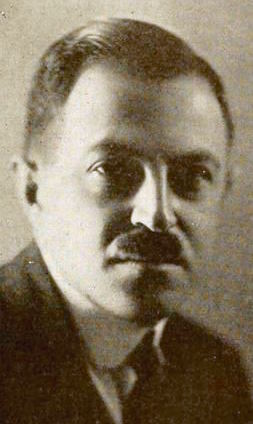
Max Fleischer was a Polish-American animator, inventor, film director and producer, and studio founder and owner. Born in Kraków, Poland, Fleischer immigrated to the United States where he became a pioneer in the development of the animated cartoon and served as the head of Fleischer Studios, which he co-founded with his younger brother Dave. He brought such comic characters as Koko the Clown, Betty Boop, Popeye, and Superman to the movie screen, and was responsible for several technological innovations, including the rotoscope, the "follow the bouncing ball" technique pioneered in the Ko-Ko Song Car-Tunes films, and the "stereoptical process". Film director Richard Fleischer was his son.

Betty Boop is an animated cartoon character created by Max Fleischer, with help from animators including Grim Natwick. She originally appeared in the Talkartoon and Betty Boop film series, which were produced by Fleischer Studios and released by Paramount Pictures. She was featured in 90 theatrical cartoons between 1930 and 1939. She has also been featured in comic strips and mass merchandising.

Talkartoons is a series of 42 animated cartoons produced by Fleischer Studios and distributed by Paramount Pictures between 1929 and 1932.

Koko the Clown is an animated cartoon character created by Max Fleischer. He first appeared as the main protagonist in Out of the Inkwell (1918–1929), a major animated series of the silent era. Throughout the series, he goes on many adventures with his canine companion "Fitz the Dog", who would later evolve into Bimbo in the Betty Boop cartoons.

"In My Merry Oldsmobile" is a popular song from 1905, with music by Gus Edwards and lyrics by Vincent P. Bryan.

"(You're the Flower of My Heart,) Sweet Adeline" is a ballad best known as a barbershop standard. It was first published in 1903, with lyrics by Richard Husch Gerard to music by Harry Armstrong, from a tune he had written in 1896 at the age of 18. According to a 1928 newspaper story, the lyrics were inspired "by a girl who worked at the music counter of a New York department store." After failing to find a publisher with the initial title, "You're the Flower of My Heart, Sweet Rosalie", according to a story the two decided a new title was in order and were inspired by a poster advertising the farewell tour of opera singer Adelina Patti. It did not become a hit until it was performed in 1904 by the group The Haydn Quartet. The Haydn Quartet's version was #1 for 10 weeks in 1904, and the Peerless Quartet also hit #1 with their version in 1904, for three weeks, according to Joel Whitburn's Pop Memories.
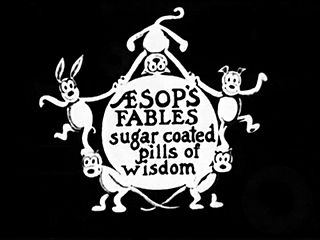
Aesop's Fables is a series of animated short subjects, created by American cartoonist Paul Terry. Produced from 1921 to 1933, the series includes Scrambled Eggs (1926), The Window Washers (1925), Small Town Sheriff (1927), Dinner Time (1928), and Gypped in Egypt (1930). Dinner Time is the first cartoon with a synchronized soundtrack ever released to the public. The series provided inspiration to Walt Disney to found the Laugh-O-Gram Studio in Kansas City, Missouri, where he created Mickey Mouse.
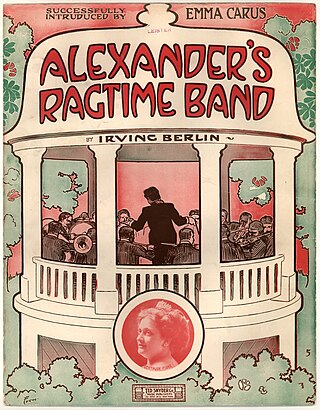
Screen Songs are a series of animated cartoons produced at the Fleischer Studios and distributed by Paramount Pictures between 1929 and 1938. Paramount brought back the sing-along cartoons in 1945, now in color, and released them regularly through 1951. Two of Paramount's one-shot cartoons quietly revived the format later: Candy Cabaret (1954) and Hobo's Holiday (1963).

Let's Sing with Popeye is a 1934 Screen Songs animated short, produced by Fleischer Studios and directed by Dave Fleischer.
Old MacDonald Had a Farm is an animated musical-comedy short, produced by Famous Studios and released by Paramount Pictures on June 7, 1946.
Ko-Ko Song Car-Tunes, Song Car-Tunes, or Sound Car-Tunes, is a series of short three-minute animated films produced by Max Fleischer and Dave Fleischer between May 1924 and September 1927, pioneering the use of the "Follow the Bouncing Ball" device used to lead audiences in theater sing-alongs. The Song Car-Tunes also pioneered the application of sound film to animation.

"Any Little Girl, That's a Nice Little Girl, Is the Right Little Girl for Me" is a popular song, first published in 1910, and written by Thomas J. Gray and Fred Fisher. Although largely forgotten today, a 1911 recording of the song by Billy Murray on Zon-O-Phone Records survives, and is widely accessible because the recording has entered the public domain. It was also featured in a Max Fleischer "Follow the Bouncing Ball" sing-a-long animated cartoon in the early 1930s. The song appears on the soundtrack of the 1933 film Stage Mother. Subsequently, in 1938 it was recorded for Bluebird Records by Shep Fields and his orchestra, with the accordionist John Serry Sr.
"Kitty from Kansas City" is a "comedy fox trot song" with lyrics by Harry Rose and music by Jesse Greer, popularized in 1930 by the singer, Rudy Vallée.
Little Annie Rooney is a short animated film that is part of the Fleischer Studios Screen Songs series. It is based on the popular song Little Annie Rooney and uses it in the soundtrack. The chorus says:

Chinatown, My Chinatown is a 1929 animated short film which was presented by Max Fleischer and directed by Dave Fleischer. The film, which was originally released by Paramount, features a sing-along version of the song "Chinatown, My Chinatown", a song that was originally published in 1910.
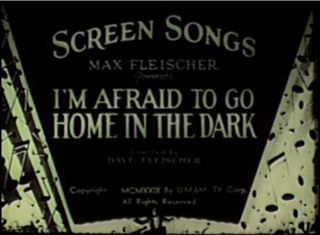
I'm Afraid to Go Home in the Dark is a 1930 animated short film which is presented by Max Fleischer and was directed by Dave Fleischer. The film, which was originally released by the film company Paramount Pictures, features a sing-along version of the song "I'm Afraid to Come Home in the Dark", which was written by Egbert Van Alstyne and Harry Williams and was originally published in 1907.
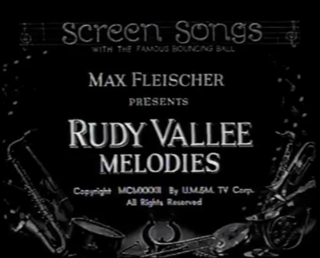
Rudy Vallee Melodies is a 1932 short film which is presented by Max Fleischer and was originally released by Paramount Pictures. The film, which features Betty Boop with a plethora of animals as she throws a house party in her house, stars Rudy Vallee as he sings three separate songs. The film also features sing-along versions to the songs that Vallee sings.
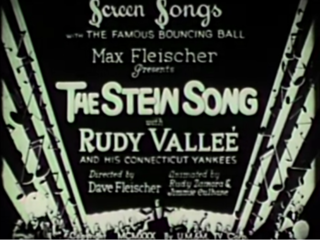
The Stein Song is a 1930 animated short film which is presented by Max Fleischer and was directed by Dave Fleischer. The film, which was animated by Rudy Zamara and Jimmie Culharne, features a sing-along version to "The Stein Song", which was written by Lincoln Colcord and was originally published in 1910. The song is also the school song for the University of Maine.

Kitty from Kansas City is a 1931 animated short film which is presented by Max Fleischer and was originally released by Paramount Pictures. The film, with features Betty Boop as she attempts to comically get to Rudy Valley, features a sing-along of the song "Kitty From Kansas City", a song that Vallee released on vinyl via the Victor record label.
References
- ↑ Pointer 2016 , p. 82
- ↑ Pointer 2016 , p. 68
- ↑ Maltin 1980 , p. 89
- ↑ Pointer 2016 , pp. 105–106
Bibliography
- Pointer, Ray (2016). The Art and Inventions of Max Fleischer: American Animation Pioneer. McFarland & Co. ISBN 978-1-4766-6367-8.
- Maltin, Leonard (1980). Of Mice and Magic: A History of American Animated Cartoons. Plume Books. ISBN 978-0-4522-5993-5.